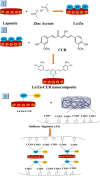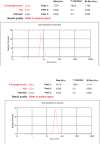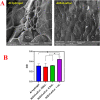Preparation and in vitro evaluation of biological agents based on Zinc-laponite- curcumin incorporated in alginate hydrogel
- PMID: 38001515
- PMCID: PMC10675890
- DOI: 10.1186/s13036-023-00391-3
Preparation and in vitro evaluation of biological agents based on Zinc-laponite- curcumin incorporated in alginate hydrogel
Abstract
Due to their outstanding structures and properties, three-dimensional (3D) hydrogels and nanoparticles have been widely studied and indicated a very high potential for medical, therapeutic, and diagnostic applications. However, hydrogels and nanoparticles systems have particular drawbacks that limit their widespread applications. In recent years, the incorporation of nanostructured systems into hydrogel has been developed as a novel way for the formation of new biomaterials with various functions to solve biomedical challenges. In this study, alginate-loaded Zinc- laponite-curcumin (Zn/La/Cur) nanocomposites were fabricated via ionic cross-linking. The prepared nanocomposite hydrogels were characterized via FTIR and FE-SEM. Moreover, energy dispersive x-ray spectroscopy (EDX) was used to study the elements of the Zn/La/Cur nanocomposite. The NIH3T3 fibroblast cell line was utilized for the MTT assay to determine the cell viability of the fabricated alginate-loaded Zn/La/Cur nanocomposites. MTT results demonstrated that there was no evidence of toxicity in the samples. These outcomes suggest that applying Al/Zn/La/Cur nanocomposite as a biological agent could be a novel tissue engineering strategy for treating soft tissue disorders.
Keywords: Alginate; Hydrogel; Laponite; Nanoparticulate systems.
© 2023. The Author(s).
Conflict of interest statement
The authors declare no competing interests.
Figures







References
-
- Sabry NM, et al. Interaction between nano silver and bacteria: modeling approach. Biointerface Res Appl Chemist. 2018;8(5):3570–3574.
-
- Landis, S., et al., Infections in chronic wounds. Chronic wound care: a clinical source book for healthcare professionals. 4th ed. Malvern, PA: HMP Communications, 2007: p. 299–321.
LinkOut - more resources
Full Text Sources

